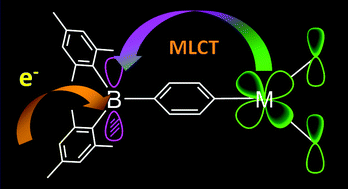 Suning Wang from Queen’s University, Canada, looks at how electron accepting triarylboranes can be used in optoelectronic applications in this Dalton Transactions Perspective article.
Suning Wang from Queen’s University, Canada, looks at how electron accepting triarylboranes can be used in optoelectronic applications in this Dalton Transactions Perspective article.
Wang and her PhD student, Zachary Hudson, discuss the role of boron, and the photophysical properties of metal-containing triarylboranes. They go on to review the recent research, looking at triarylboron-containing complexes in OLEDs and as anion sensors, as well their use in MOFs, zinc sensors and as vapochromic materials to detect VOCs.
Read the full article to find out more…
Metal-containing triarylboron compounds for optoelectronic applications
Zachary M. Hudson and Suning Wang
Dalton Trans., 2011, 40, 7805-7816
DOI: 10.1039/C1DT10292C
Professor Wang is an Associate Editor for our new journal, RSC Advances, read more about her research.
Comments Off on Perspective: Suning Wang on triarylboron compounds for optoelectronics
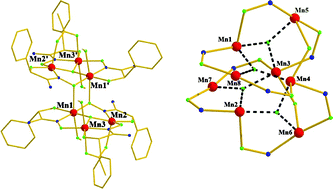

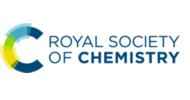









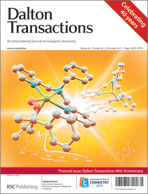

![The organometallic anticancer complex [(η6-p-cymene)Ru(en)Cl]PF6](http://pubs.rsc.org/services/images/RSCpubs.ePlatform.Service.FreeContent.ImageService.svc/ImageService/image/GA?id=C1DT11189B) Peter Sadler from Warwick University, and collaborators at the Chinese Academy of Sciences have developed a ruthenium arene anticancer complex that inhibits the action of protein tyrosine phosphatase 1B, which regulates insulin levels.
Peter Sadler from Warwick University, and collaborators at the Chinese Academy of Sciences have developed a ruthenium arene anticancer complex that inhibits the action of protein tyrosine phosphatase 1B, which regulates insulin levels. Suning Wang from Queen’s University, Canada, looks at how electron accepting triarylboranes can be used in optoelectronic applications in this Dalton Transactions Perspective article.
Suning Wang from Queen’s University, Canada, looks at how electron accepting triarylboranes can be used in optoelectronic applications in this Dalton Transactions Perspective article.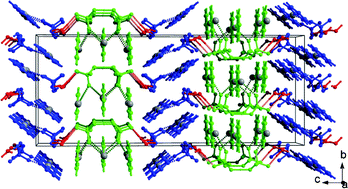


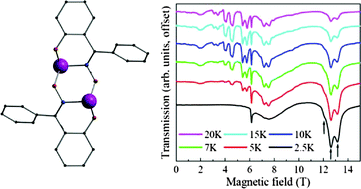 In this HOT Article, the serendipitous self-assembly of the complex [MnIII2ZnII2(Ph-sao)2(Ph-saoH)4(hmp)2], whose magnetic core consists solely of two symmetry equivalent Mn(III) ions linked by two symmetry equivalent –N–O– moieties, provided Brechin and co-workers with a relatively simple model complex with which to study the magneto-structural relationships in more complicated polynuclear oxime-bridged Mn(III) cluster compounds.
In this HOT Article, the serendipitous self-assembly of the complex [MnIII2ZnII2(Ph-sao)2(Ph-saoH)4(hmp)2], whose magnetic core consists solely of two symmetry equivalent Mn(III) ions linked by two symmetry equivalent –N–O– moieties, provided Brechin and co-workers with a relatively simple model complex with which to study the magneto-structural relationships in more complicated polynuclear oxime-bridged Mn(III) cluster compounds. In this HOT article, Díaz-Torres and Alvarez have developed a scale which attempts to quantify the weakly coordinating character of a variety of solvents and anions towards a transition metal or a lanthanide. This was made possible by analyzing crystal structures for the presence of coordinated and uncoordinated groups (solvents or anions) in the presence of a transition metal or a lanthanide and extracting from this coordinating ability indices. These indices should prove very useful in providing general trends allowing comparison between different solvents or anions and should be very useful for the broad organometallic community.
In this HOT article, Díaz-Torres and Alvarez have developed a scale which attempts to quantify the weakly coordinating character of a variety of solvents and anions towards a transition metal or a lanthanide. This was made possible by analyzing crystal structures for the presence of coordinated and uncoordinated groups (solvents or anions) in the presence of a transition metal or a lanthanide and extracting from this coordinating ability indices. These indices should prove very useful in providing general trends allowing comparison between different solvents or anions and should be very useful for the broad organometallic community.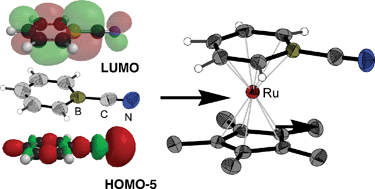 In this HOT article, Cade and Hill describe the synthesis of a salt of the 1-borabenzonitrile anion as its tetrabutylammonium salt and a preliminary exploration of its coordination chemistry in which it behaves as neither a conventional nitrile nor an isonitrile. The authors present computational, spectroscopic and crystallographic evidence for the heterocycle and a ruthenium complex containing the anion as an “arene” ligand.
In this HOT article, Cade and Hill describe the synthesis of a salt of the 1-borabenzonitrile anion as its tetrabutylammonium salt and a preliminary exploration of its coordination chemistry in which it behaves as neither a conventional nitrile nor an isonitrile. The authors present computational, spectroscopic and crystallographic evidence for the heterocycle and a ruthenium complex containing the anion as an “arene” ligand.